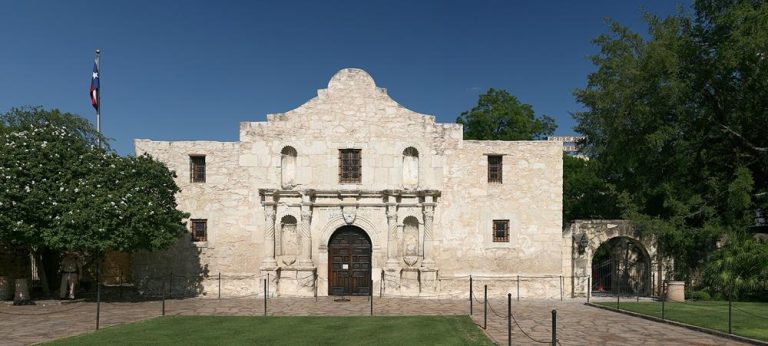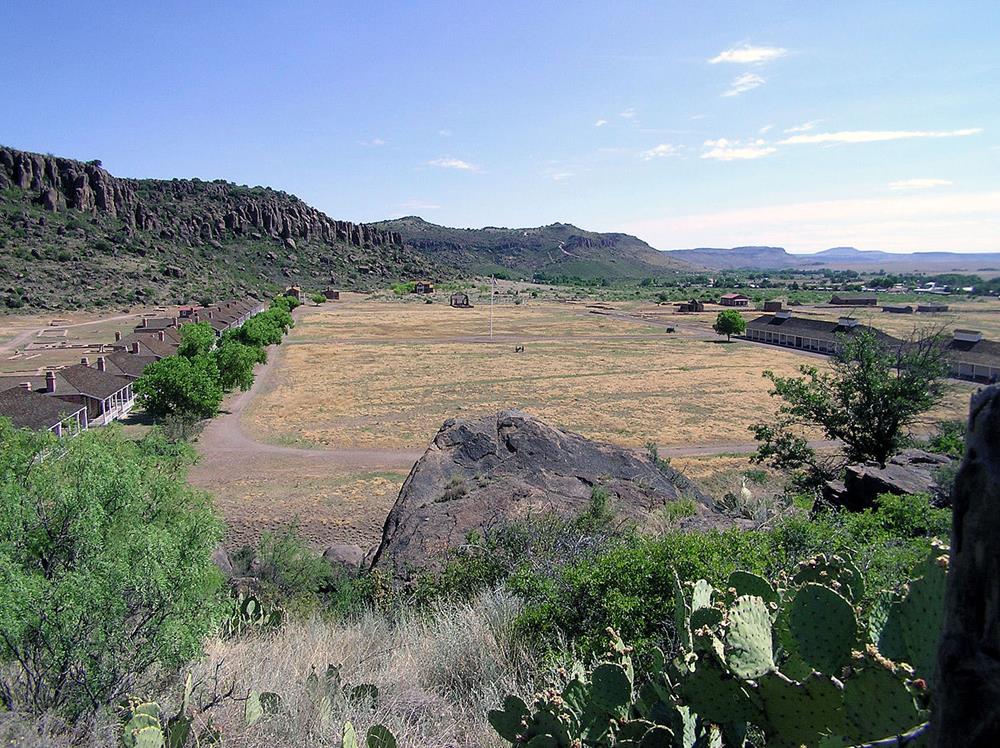Sites like the San Jacinto Monument, Washington-on-the-Brazos State Historic Site, and Casa Navarro provide insight into political change, cultural heritage, and the stories of individuals who helped shape the Lone Star State.
From museums showcasing rare artifacts to historic landmarks, living history locations, and preserved estates like Fulton Mansion and the French Legation, each place adds to the understanding of Texas history.
Whether interested in early colonization, military events, or the evolution of Texas into a state, these historic sites—including the Fort Worth Stockyards and USS Lexington—give a tangible connection to the events and people who define Texas.
1. Panhandle-Plains Historical Museum
The Panhandle-Plains Historical Museum in Canyon is recognized as the largest history museum in Texas. With more than 2 million artifacts, its collection highlights various aspects of the region, from prehistoric fossils to artwork.
Key features include:
- Exhibits on pioneer settlements
- Displays of Native American objects
- Insights into the development of the oil industry
The museum provides an in-depth view of the Panhandle-Plains region’s cultural and natural heritage.
2. Guadalupe Mountains National Park
Guadalupe Mountains National Park protects a landscape shaped by ancient geological forces, including Guadalupe Peak, the tallest summit in Texas. The area offers a variety of hiking opportunities through environments filled with unique plants and animals.
Points of interest include the historic Frijole Ranch, established in the late 1800s, where visitors can learn about pioneer life. The ranch was added to the National Register of Historic Places in 1978. The park also preserves evidence of early ranching and mining in the region.
3. Fort Davis National Historic Site
Fort Davis National Historic Site in Texas stands as one of the best-maintained examples of a western frontier military outpost. The grounds feature restored barracks, officer residences, and a historic hospital, each reflecting the daily routines and challenges of military personnel during the mid to late nineteenth century.
Key Highlights:
- Location: Fort Davis, Texas
- Structures: Barracks, officer’s quarters, hospital, ruins
- Purpose: Protected settlers, mail, and freight on key travel routes
Interactive exhibits and short films at the visitor center further enrich the educational experience.
4. Seminole Canyon Park and Historic Area
View this post on Instagram
Seminole Canyon State Park & Historic Site stands out for its ancient pictographs, some created by early inhabitants over 4,000 years ago. Along the trails, guests can spot striking images painted by prehistoric cultures.
Highlights include:
- Well-maintained hiking paths
- Dramatic canyon scenery for photography
- Campgrounds for overnight visits
- Opportunities to observe unique bird species
The visitor center displays artifacts and details about the canyon’s past, enhancing the educational experience for all ages.
5. Dinosaur Valley State Park
View this post on Instagram
Located in Glen Rose, Dinosaur Valley State Park is known for its visible dinosaur footprints preserved in the bed of the Paluxy River, dating back over 100 million years. Hiking trails wind through scenic landscapes. Families can picnic, camp, or view life-sized dinosaur models.
The visitor center features educational exhibits on geology and fossils. Track sites are clearly marked, allowing guests to stand where dinosaurs once walked.
6. Sixth Floor Museum at Dealey Plaza
Located in downtown Dallas, the Sixth Floor Museum stands inside the historic Texas School Book Depository. It presents an in-depth look at President John F. Kennedy’s life and his presidency.
Key features:
- Authentic artifacts, photos, and documentary footage
- Timelines and exhibits on November 22, 1963
- Insights into the official investigations
- Reflections on national impact
The museum’s setting allows visitors to experience the historical significance firsthand.
7. Nacogdoches
Nacogdoches earns its distinction as Texas’s oldest town, with roots reaching back to a 1716 Spanish mission. Visitors can explore key historic sites such as:
- Old Stone Fort Museum: Offers perspectives on the area’s evolution from Spanish control through revolutionary times.
- Millard’s Crossing Historic Village: Provides a look at 19th-century life with preserved and restored buildings.
- Sterne-Hoya House Museum: Features exhibits from the 1830s, illustrating daily life in early Texas.
These locations highlight Nacogdoches’s integral role in the state’s history.
8. San Jacinto Battlefield Historic Site
The San Jacinto Battleground State Historic Site commemorates the critical 18-minute conflict that shaped the outcome of the Texas Revolution. Visitors encounter the impressive San Jacinto Monument, which is marginally taller than the Washington Monument and serves as a symbol of Texas independence.
Nearby, the San Jacinto Museum showcases artifacts and exhibitions related to the battle, early Texas history, and the revolution’s wider significance. For those interested in special presentations, the site periodically hosts live events, including cannon firings and historical demonstrations, making it an engaging destination for history enthusiasts.
9. San Felipe de Austin State Historic Site
View this post on Instagram
San Felipe de Austin played a pivotal role as the hub for early Anglo-American settlers in Texas, guided by Stephen F. Austin. The historic site features a museum and a reconstructed area, allowing visitors to see firsthand how the early community was organized and how it grew. Exhibits and displays provide context about the colonists’ lives, challenges, and progress.
Key highlights:
- Original location of Stephen F. Austin’s colony
- Museum with artifacts and interactive elements
- Recreated townsite showing early settlement layout
- Insights into Texas’s early development
10. The Texas Capitol Landmark
The Texas State Capitol stands as an iconic centerpiece in Austin, recognized for both its historical importance and architectural beauty. Completed in 1888, it surpasses the U.S. Capitol in size and remains a notable Texas symbol.
Key Features:
- Ornate dome
- Expansive legislative chambers
- Beautiful rotunda
- Landscaped public grounds
Guided tours are available, offering insights into the state’s legislative history and cultural heritage. The Capitol’s presence highlights Texas’s long-standing traditions and civic pride.
11. The Driskill Hotel
View this post on Instagram
Set in the heart of Austin, The Driskill Hotel dates back to 1886 and stands as a notable example of Texas heritage. Its distinguished Romanesque architecture, detailed with ornate columns and grand public spaces, draws architecture enthusiasts and history lovers alike.
Key highlights:
- Prominent site for important gatherings and political milestones
- Frequently visited by renowned figures
- Known for lavish interiors and rich décor
A popular local legend holds that it is among the most haunted hotels in Texas, adding an intriguing aspect for guests and visitors. Whether stopping by the elegant lobby or booking a stay, many guests appreciate its unique atmosphere.
12. LBJ Presidential Library
Located in Austin, the LBJ Presidential Library preserves the legacy of Lyndon B. Johnson, the 36th U.S. president. The museum presents displays on significant topics such as the Civil Rights Act, the Vietnam conflict, and initiatives known as the Great Society.
Exhibits and Features:
- Authentic artifacts, documents, and photographs
- A detailed replica of the Oval Office from Johnson’s administration
- Materials offering a look into pivotal moments of his presidency
Visitors gain firsthand perspectives on Johnson’s influence upon American history through interactive and visual experiences.
13. Mission San José
View this post on Instagram
Mission San José, part of San Antonio Missions National Historical Park, stands out for its restored structures and historical significance. Founded in 1720, it provides visitors with a look into Spanish colonial times. The site includes a church, granary, original living quarters, and a well-designed stone wall featuring arches.
Key Features:
- Visitor center with exhibits on mission heritage
- Picturesque gardens surrounding the mission
- Noted for its architecture, including striking arches and sturdy stonework
The mission’s layout reflects the daily life and culture of its residents. Many guests find educational displays and peaceful outdoor areas suited to learning and reflection. It remains one of the most recognizable landmarks among the San Antonio missions.
14. Alamo
The Alamostands as an enduring landmark in Texas, recognized for its role in the Texas Revolution of 1836. As a former Spanish mission, it later became the site where a small group of defenders resisted a much larger Mexican force.
Key highlights for visitors:
- Tour the preserved mission buildings
- View historic artifacts from the famous battle
- Explore landscaped gardens
- Visit the museum to gain insight into the site’s significance
The location represents both a memorial to those who fought and a symbol of Texas resilience.
15. Goliad State Park & Historic Site
Set along the San Antonio River, this park highlights two important landmarks: Mission Espíritu Santo and the Presidio La Bahía. Both locations have been restored, inviting visitors to explore the architectural features and daily routines of early Spanish and Texan settlers. Goliad State Park marks the site of the Goliad Massacre, an event deeply intertwined with the Texas Revolution.
Historic Landmarks in the Park:
| Site | Significance |
|---|---|
| Mission Espíritu Santo | Center for Spanish colonial mission activities |
| Presidio La Bahía | Fortification and pivotal Texas Revolution site |
The area offers a unique perspective on Texas history as well as tranquil, scenic grounds.
16. Palo Alto Battlefield National Historical Park
Located close to Brownsville, Palo Alto Battlefield National Historical Park represents the site of the opening clash of the Mexican-American War in 1846. This carefully preserved landscape allows visitors to walk the grounds where the pivotal battle unfolded and discover its influence on the future borders of the United States and Mexico.
The park’s visitor center offers informative exhibits, authentic artifacts, and engaging films.



